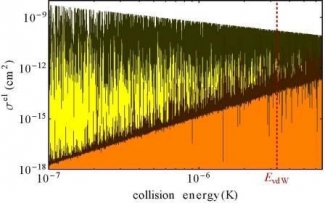Balls of clay may stick to each other when they collide. This is because the original energy they had before the collision gets so mixed up in heating the clay that the balls have none left to separate. Molecules, particularly small ones, don't generally act this way, since there are not many places for the energy to disappear into. However, Michael Mayle, Brandon Ruzic, and Goulven Quéméner have discovered that at ultralow temperatures, some might actually stick. For example, RbCs molecules (cross section below) may have myriad opportunites to waste energy in rotations and vibrations, rather than in getting away from each other. They should eventually escape this mess, but on time scales long enough to affect the experiment.





